Genre: Racing Developer: Sterling Silver Software Publisher: Tengen Players: 1 Released: 1990
After hitting start four times, you find yourself on the racing track, next to three other cars. You hit “A” to accelerate, though your car seems to move as though it were slogging through molasses. You notice a fork in the road where the other cars turn right, so you try to follow them, sending your car careening off the road. And while you wonder what that strange cardboard cutout is doing at the side of the road, you hit the wide side of a barn while, shortly before it is cut off by a horribly crash sound effect, you could swear you heard a cow mooing… Welcome to what might just possible be your first twenty seconds of Hard Drivin’ for the Genesis!
Note how you won’t see the official SEGA logo when you start up this game! Yes, this cartridge has been brought to you by Tengen, the proud Atari subsidiary that ported unofficial home console versions of arcade games to the NES and Sega Genesis (like Snow Bros., Pit-Fighter, Klax, or the legendary and rarest title of them all, the Genesis version of Tetris). Back in 1988, when Hard Drivin’ hit the arcades, the game was advertised as being “the world’s first authentic driving simulation game.” Judging from the controls and the graphics, and comparing them to recent driving games – man, we’ve come a long way in twenty years! Yes, the comparison is sort of unfair, but you have to admit, it is pretty impressive to see what constituted a realistic driving simulation just one (human) generation ago.
But back in its time, this game was truly an innovation. As the story goes, it was originally meant to be a high-speed chase simulator for police. When that project fell through, Atari decided to pep it up with a stunt track and toss it into the arcade. Instead of flat bitmap graphics, Hard Drivin’ was one of the first attempts to truly emulate a 3D Driving Simulation (using polygons), employing the help of an arcade cabinet shaped like a Ferrari Testarossa. Plus, with a loop-de-loop, ramps and tilted roads, this “stunt driving simulation” made the game an actual arcade success, inspiring many other titles (many I know grew up with Amiga or PC games like Stunt Car Racer or 4D Sports Driving aka Stunts. Yes, Hard Drivin’ came first!) and kickstarting the 3D Race genre.
Well, so much for the history lesson. But what about the Genesis port? Can 16-bit power do this game justice? Well, if properly implemented, it might. The way the game is, however, the answer is a straight no!
The idea of a stunt track in 3D is a great one, but this port, unfortunately, is not. As insinuated in my beginning paragraph, the game has a problem with slowdown. As long as other cars (or big objects, like huts or barns) are on the screen, things drag down immensely. This can be a problem when you encounter oncoming traffic (oh yeah!). You don’t see the cars as much as feel them first, because suddenly the game slows down and the controls become a tad less responsive, which won’t help if you try to avoid the car, so you’ll probably just crash right into it if you’re on the wrong side of the road.
Ah yes, the crashes. You don’t have many sound effects in the game – roaring engine, “screaming” tires, and crashing into things – all sounding rather tinny and flat. Oh yes, and there’s a cardboard cutout-like cow that moos when you hit it as an easter egg as well.
All that would still be rather acceptable, but here’s the biggest problem: The length – or rather, the lack thereof! You just have a single track! Race straight ahead, and you have the “Speed Track” (which I have to admit can actually get pretty speedy and fun as long as you don’t encounter any other cars). Turn right after starting, and you’re on the stunt track – which would be fun if it would just run as smooth as the racetrack in its best sections! You get a “qualifying round” lasting 1:45 minutes (if you make it to the checkpoints in due time, you can get bonus rounds enabling you to finish several laps). Complete a round in under 1:40, and you face off against an opponent. This race, however, is both fun and a nice idea: You race against a “ghost car” (without the oncoming traffic, so this race runs far smoother and is therefore a lot easier than the actual qualifying round). Once you’re able to beat it in the challenge (that is, complete a single round in under 1:35), the game remembers that time. The next qualifying round then necessitates you to qualify within at least a five second margin of your race result – and the next race challenge will be against yourself! This can make for a kind of multi-player challenge – beat the race, then hand the controller to your buddy and dare him beat you! Or try to improve your own time – it’s oddly encouraging trying to best your actual self! Unfortunately, the game won’t save your best times, so once you turn the Genesis off, it’ll all be gone!
Reaching that part actually kind of redeems Hard Drivin’. Plus, the actual main theme on the title screen is kind of catchy! Sadly, there are so many things wrong with it – most notably the slowdown, the sound effects, the lack of actual content (just one-and-a-half race tracks and one car using either manual or automatic gear shifting) and next to no decent music (there are only three tracks, the rocking – albeit short – main theme, and two boring, tinny tracks during credits and high scores). You have to play for a while to grow to like it, while at the same time the fun only lasts a few minutes. I guess most of the problems could’ve been solved by a bigger cartridge size – but as it is, this game uses only two MEGs, making it one of the smallest games in the Genesis library! Tengen tried to address that problem in a later game. This, however, is sadly just so much wasted potential, still likable in way, but not really entertaining in the long run.
SCORE: 4 out of 10

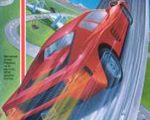
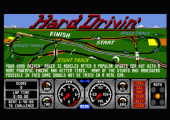
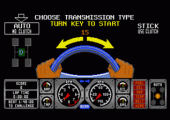
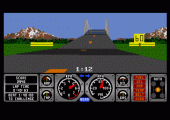
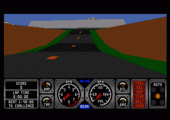
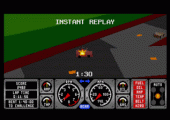
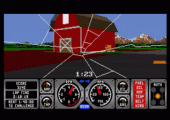
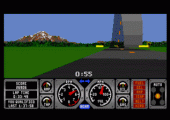
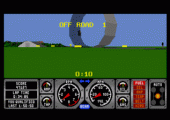
Recent Comments